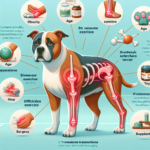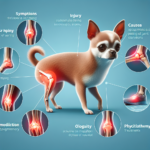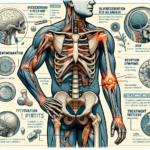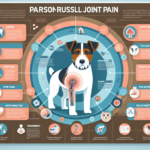Biewer Terrier Joint Pain: Causes, Symptoms, Prevention, and Treatment
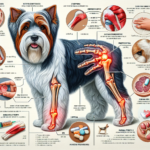
Introduction
The Biewer Terrier, a charming and elegant toy breed, has captured the hearts of dog lovers worldwide. Originating in Germany in the 1980s, this breed was developed by Werner and Gertrud Biewer from Yorkshire Terriers. Known for their distinctive tri-colored coats and playful, affectionate nature, Biewer Terriers make excellent companions. Despite their small size, they are robust and energetic, often surprising their owners with their spirited demeanor.
Like all breeds, Biewer Terriers are prone to certain health issues. Common concerns include dental problems, patellar luxation, and liver shunts. However, one of the most significant health issues that can affect their quality of life is joint pain. Given their active nature, maintaining joint health is crucial for Biewer Terriers to ensure they lead a happy and pain-free life.
Breed-Specific Joint Pain Risks
Genetic Predisposition
Biewer Terriers, like many small breeds, are genetically predisposed to joint-related issues. One of the most common conditions is patellar luxation, where the kneecap dislocates from its normal position. This condition can lead to pain, lameness, and eventually arthritis if not addressed. While hip dysplasia is more common in larger breeds, it can occasionally be seen in Biewer Terriers, contributing to joint pain and mobility issues.
Age-Related Risks
As Biewer Terriers age, the risk of developing joint pain increases. Degenerative joint diseases such as osteoarthritis can set in, leading to chronic pain and stiffness. Typically, signs of joint pain may start to appear in middle age, around 5-7 years old, but this can vary depending on the individual dog’s genetics and lifestyle.
Activity Level and Joint Stress
Biewer Terriers are known for their high energy levels and playful nature. While regular exercise is essential for their overall health, excessive or inappropriate activities can put undue stress on their joints. Jumping from heights, running on hard surfaces, or engaging in high-impact activities can exacerbate joint issues, especially if the dog already has a predisposition to such problems.
Common Symptoms of Joint Pain in Biewer Terriers
General Symptoms
Owners should be vigilant for signs of joint pain in their Biewer Terriers. Common symptoms include:
- Limping or favoring one leg
- Stiffness, especially after rest
- Reluctance to jump, run, or climb stairs
- Decreased activity or playfulness
- Whining or yelping when moving
- Swelling around the joints
Breed-Specific Symptoms
In Biewer Terriers, patellar luxation may present as a sudden skipping or hopping gait, where the dog momentarily holds up one leg. This can be intermittent and may not always be accompanied by obvious pain, making it crucial for owners to monitor their pets closely.
When to Consult a Vet
If any of the above symptoms are observed, it is essential to consult a veterinarian promptly. Early diagnosis and intervention can significantly improve the prognosis and quality of life for a dog suffering from joint pain.
Preventive Measures for Joint Health
Exercise Recommendations
Regular, low-impact exercise is vital for maintaining joint health in Biewer Terriers. Activities such as walking, swimming, and gentle play are excellent choices. Avoid high-impact exercises like jumping or running on hard surfaces, which can exacerbate joint stress.
Dietary Suggestions
A balanced diet rich in essential nutrients can support joint health. Consider incorporating foods or supplements that contain:
- Glucosamine and Chondroitin: These compounds help maintain cartilage health and reduce inflammation.
- Omega-3 Fatty Acids: Found in fish oil, these fatty acids have anti-inflammatory properties that can benefit joint health.
- Antioxidants: Vitamins C and E can help reduce oxidative stress on joints.
Weight Management
Maintaining a healthy weight is crucial for reducing joint stress. Overweight dogs are at a higher risk of developing joint issues due to the additional load on their joints. Regularly monitor your Biewer Terrier’s weight and adjust their diet and exercise routine as needed to keep them at an optimal weight.
Early Screening and Monitoring
Regular veterinary check-ups are essential for early detection of joint issues. Screening tests such as X-rays or joint fluid analysis can help identify problems before they become severe. Additionally, monitoring your dog’s movement and behavior can provide early clues to potential joint pain.
Treatment Options for Joint Pain
Non-Surgical Treatments
For many Biewer Terriers, non-surgical treatments can effectively manage joint pain. These may include:
- Medications: Nonsteroidal anti-inflammatory drugs (NSAIDs) can help reduce pain and inflammation. Always consult a vet before administering any medication.
- Physical Therapy: Exercises and therapies designed to strengthen muscles and improve joint function can be beneficial.
- Lifestyle Adjustments: Modifying activities to reduce joint stress and providing a comfortable living environment can help manage pain.
Surgical Options
In severe cases, surgical intervention may be necessary. Common surgeries for joint pain in Biewer Terriers include:
- Patellar Luxation Surgery: Realigning the kneecap to prevent dislocation.
- Hip Dysplasia Surgery: Procedures such as femoral head ostectomy (FHO) or total hip replacement (THR) can alleviate pain and improve mobility.
Alternative Therapies
Alternative treatments can complement traditional therapies and provide additional relief. These may include:
- Acupuncture: This ancient practice can help reduce pain and inflammation.
- Hydrotherapy: Water-based exercises can improve joint function without putting stress on the joints.
- Massage: Regular massages can help relieve muscle tension and improve circulation.
Lifestyle and Management Tips
Daily Care Routine
A consistent daily care routine can help manage joint pain in Biewer Terriers. This may include:
- Regular, gentle exercise to maintain mobility
- A balanced diet with joint-supporting supplements
- Administering prescribed medications as directed by a vet
- Providing a comfortable resting area with orthopedic bedding
Modifying the Home Environment
Making small changes to your home can significantly improve your dog’s comfort. Consider:
- Installing ramps or steps to help your dog access furniture or climb stairs
- Using non-slip mats to prevent falls on slippery surfaces
- Providing an orthopedic bed to support joints during rest
Long-Term Management
Long-term management of joint pain involves regular monitoring and adjustments. Keep track of your dog’s condition and consult your vet regularly to update treatment plans as needed. Ensuring your Biewer Terrier remains active, comfortable, and pain-free will enhance their quality of life.
FAQs About Biewer Terriers and Joint Pain
What are the early signs of joint pain in Biewer Terriers?
Early signs include limping, stiffness, reluctance to move, and decreased activity levels. If you notice any of these symptoms, consult your vet for a thorough examination.
Can joint pain in Biewer Terriers be prevented?
While genetic predispositions cannot be entirely prevented, maintaining a healthy weight, providing appropriate exercise, and offering a balanced diet with joint-supporting supplements can significantly reduce the risk of joint pain.
Are there specific exercises that are better for Biewer Terriers with joint pain?
Low-impact exercises such as walking and swimming are ideal for Biewer Terriers with joint pain. Avoid high-impact activities that can exacerbate joint stress.
What dietary supplements can help with joint health in Biewer Terriers?
Supplements containing glucosamine, chondroitin, and omega-3 fatty acids can support joint health. Always consult your vet before adding any supplements to your dog’s diet.
When should I consider surgery for my Biewer Terrier’s joint pain?
Surgery should be considered when non-surgical treatments are no longer effective, and your dog’s quality of life is significantly impacted. Consult your vet to discuss the best surgical options for your pet.
Conclusion
Joint pain is a significant concern for Biewer Terriers, but with proper care and attention, it can be managed effectively. By understanding the causes, symptoms, and preventive measures, owners can take proactive steps to ensure their dogs remain healthy and active. Regular veterinary check-ups, a balanced diet, appropriate exercise, and a comfortable living environment are crucial for maintaining joint health. Remember, early intervention is key to preventing severe joint issues and ensuring your Biewer Terrier leads a happy, pain-free life.
Encourage readers to consult their veterinarian regularly and take preventive measures to safeguard their dog’s joint health. With the right care, Biewer Terriers can enjoy a long, active, and fulfilling life.

